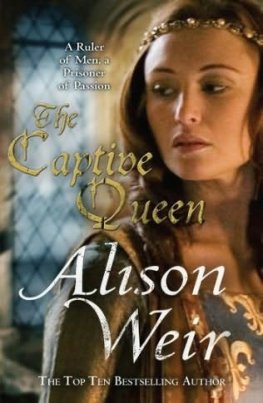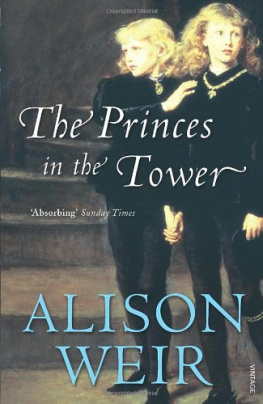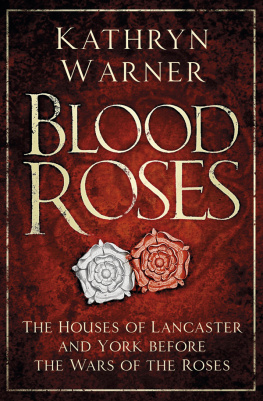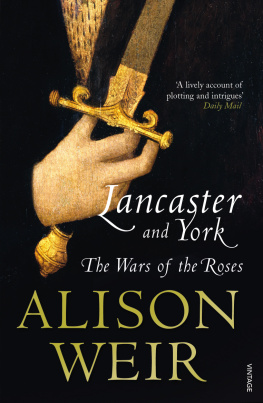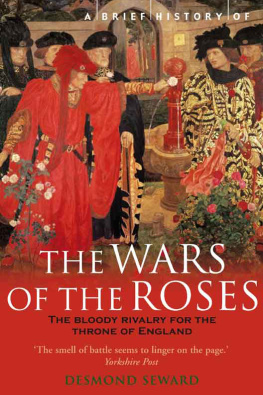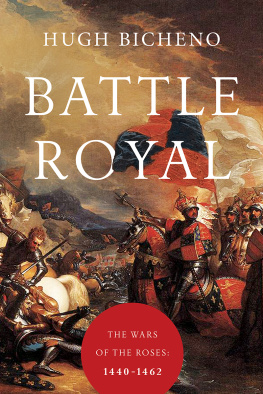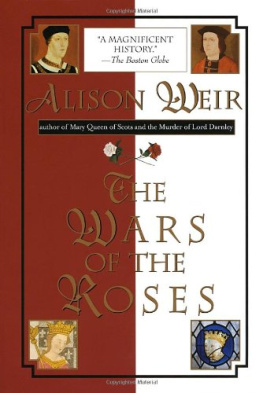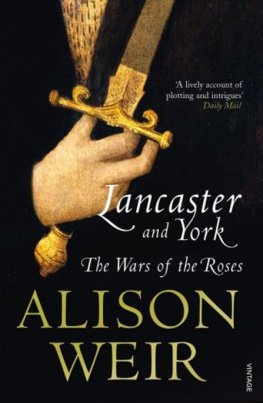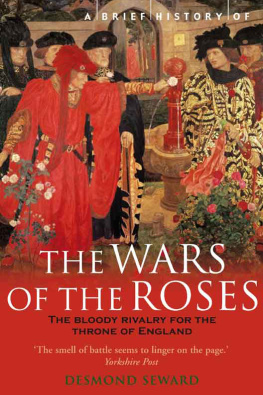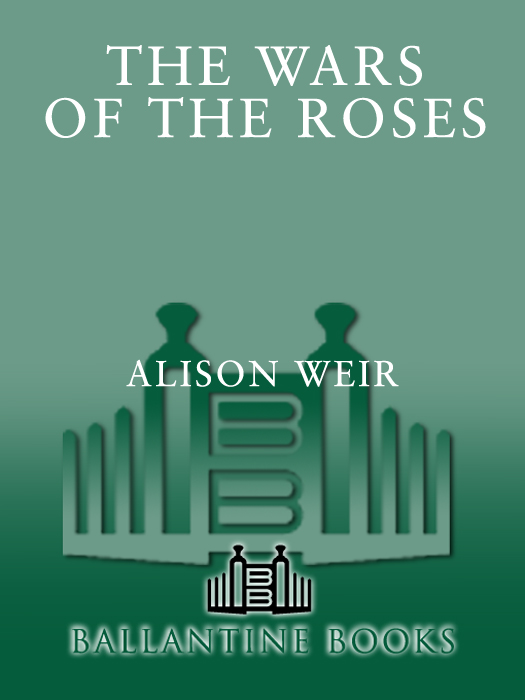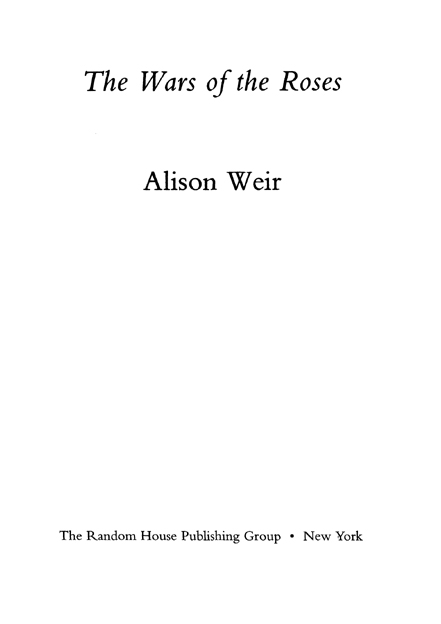POWERFUL AND ELEGANT
A complicated story brilliantly told.
Kirkus Reviews
Elegantly written, revealingly detailed, and effortlessly narrated Splendid work Among her gifts, Weir has the two strengths essential to the historian: She writes with equal command about people as individuals and about the nature of power. Throughout, she is a canny and engaging guide to the unspeakably tangled workings of late-medieval political power. Military might, bloodlines, family alliances, regional loyalties, charisma, theatrics and image, revenge, greed, ruthlessness, and expediency all operated in tortuous formations and are here meticulously opened to scrutiny.
Boston Globe
[A] perfectly focused and beautifully unfolded account.
Booklist (starred review)
Stimulating A well-written, entertaining narrative.
Library Journal
A Ballantine Book
Published by The Random House Publishing Group
Copyright 1995 by Alison Weir
All rights reserved under International and Pan-American Copyright Conventions. Published in the United States by The Random House Publishing Group, a division of Random House, Inc., New York.
Originally published as Lancaster & York in Great Britain in 1995 by Jonathan Cape, Random House, UK Ltd., London.
Ballantine and colophon are registered trademarks of Random House, Inc.
www.ballantinebooks.com
Library of Congress Catalog Card Number: 96-96058
eISBN: 978-0-307-80685-7
v3.1
Contents
Illustrations
PLATES
Richard II, portrait by an unknown artist in Westminster Abbey c. 1395 (by courtesy of the Dean and Chapter of Westminster)
John of Gaunt, late sixteenth-century portrait attributed to Luca Cornelli (by kind permission of the Duke of Beaufort; photograph by Peter A. Harding)
Henry IV, electrotype of the tomb effigy in Canterbury Cathedral (National Portrait Gallery, London)
Henry V, late fifteenth-century portrait by an unknown artist in the Royal Collection ( 1995 Her Majesty Queen Elizabeth II)
Humphrey, Duke of Gloucester (kneeling before the Man of Sorrows), from a Book of Psalms made for him c. 142030 (by permission of the British Library: Royal 2 B I f.8)
Cardinal Henry Beaufort, tomb effigy in Winchester Cathedral (by courtesy of the Dean and Chapter of Winchester)
Henry VI, portrait by an unknown artist c.1530 (National Portrait Gallery, London)
Henry VI, late sixteenth/early seventeenth-century portrait by an unknown artist (National Portrait Gallery, London)
Ren, Duke of Anjou, portrait miniature by Nicholas Froment from the Matheron Diptych, c. 1476, in the Louvre Museum, Paris ( photograph R.M.N.)
Margaret of Anjou, portrait medallion by Pietro de Milano, c. 14623 (by courtesy of the Trustees of the Victoria and Albert Museum)
Richard, Duke of York, from a stained-glass window in the Trinity Chapel at St John the Baptist, Cirencester (by kind permission of the Vicar and Churchwardens of Cirencester Parish Church; photograph by Bryan Berkeley)
The Falcon and Fetterlock badge of the mediaeval dukes of York, from the gates of Henry VIIs Chapel in Westminster Abbey (by courtesy of the Dean and Chapter of Westminster)
Jack Cades rebellion of 1450, from Les Chroniques de France, c. 1500 (by permission of the British Library: Royal 20 E 111 f.28)
Plucking the Red and White Roses in the Temple Gardens, 1910, by Henry A. Payne, House of Commons East Corridor ( RCHME Crown Copyright)
Ludlow Castle ( RCHME Crown Copyright)
Interior of Westminster Hall, looking south, c. 1925 (Farmer Collection, House of Lords Record Office)
Edward IV, portrait by an unknown artist c. 1530 (National Portrait Gallery, London)
Elizabeth Wydville, portrait by an unknown artist c. 1465 (by courtesy of the President and Fellows of Queens College, Cambridge)
Richard Neville, Earl of Warwick, portrayed as a weeper on a tomb in St Marys Church (photograph by Marianne Majerus)
George, Duke of Clarence and his family, from the Rous Roll c. 14835 (by permission of the British Library: Add.48976 figs. 5860)
Edward IV sets sail from Flushing, from a fifteenth-century manuscript (by permission of the British Library: Harley 7353 no. 10)
Edward IV watches the execution of the Duke of Somerset, from Historie of the Arrival of Edward IV, late fifteenth century (University Library of Ghent: MS 236)
The Oratory in the Wakefield Tower at the Tower of London (Historic Royal Palaces Photo Library)
MAPS
Introduction
W hen I was working on my last book, The Princes in the Tower, I was aware that in some respects I was telling only half a story. I was writing about the final phase of that conflict so picturesquely named the Wars of the Roses, a conflict that lasted for more than thirty years, from 1455 to 1487. There were, in fact, two Wars of the Roses; the first, lasting from 1455 to 1471, was between the royal houses of Lancaster and York, and the second, from 1483 to 1487, was between the royal houses of York and Tudor. Having touched only briefly on the former in The Princes in the Tower, which describes in some detail the second phase of the wars, I felt that a prequel might be an interesting book with which to follow it. This present book, then, is the story of Lancaster and York and the first of the Wars of the Roses.
During the course of my research, I have studied many sources, both ancient and modern, and of the modern ones nearly all focus primarily upon the practical and military aspects of my subject. This book will naturally touch upon those matters, and in some detail in parts, but my main intention has been to portray the human side of history the people and personalities involved, the chief protagonists in one of the most fascinating and long-drawn-out feuds in English history.
At the centre of this bloody faction fight was the pathetic figure of the mentally unstable Henry VI, whose ineptitude in government and mental incapacity gave rise to political instability, public discontent, and dissensions between the great landed magnates that in turn led ultimately to war and a bitter battle over the throne itself. Henrys chief rival was Richard Plantagenet, Duke of York, the man who should have been king, according to the law of primogeniture as it was then understood. After Yorks death, his claim to the throne was inherited by his son, who became King Edward IV, a ruthless charmer who would in the end bring about the ruin of the House of Lancaster.
This book is also the story of a womans bitter and tenacious fight for her sons rights. Henrys queen, Margaret of Anjou who was accused by her enemies of having planted a bastard in the royal nursery took up arms in the cause of Lancaster and battled over many years and against seemingly insurmountable odds for the rights of her husband and child. This was remarkable in itself, for she was a woman in a violent mans world, in which most members of her sex were regarded as movable goods, chattels and political nonentities.
There are many other human faces in the unfolding pageant of treason and conflict. Margarets son, Edward of Lancaster, inured to violence at an early age, shocked his contemporaries by his callous precocity. Richard Neville, Earl of Warwick Warwick the Kingmaker was the archetypal over-mighty subject of the late Middle Ages, who raised and deposed kings, yet whose loyalty, in the final analysis, was only to himself. The Wars of the Roses would not only bring about the fall of a royal dynasty but also that of magnates such as Warwick.






